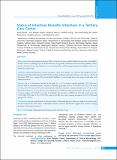Please use this identifier to cite or link to this item:
https://hdl.handle.net/20.500.14356/914| Title: | Status of Intestinal Parasitic Infections in a Tertiary Care Center |
| Authors: | Basnet, Ajaya Chand, Arun Bahadur Pokhrel, Nayanum Gurung, Parbati Rai, Junu Richhinbung Bajracharya, Sohani Acharya, Sadiksha Shrestha, Lok Bahadur |
| Citation: | BasnetA., ChandA. B., PokhrelN., GurungP., RaiJ. R., BajracharyaS., AcharyaS., & ShresthaL. B. (2022). Status of Intestinal Parasitic Infections in a Tertiary Care Center . Journal of Nepal Health Research Council, 20(02), 505-509. https://doi.org/10.33314/jnhrc.v20i02.4049 |
| Issue Date: | 2022 |
| Publisher: | Nepal Health Research Council |
| Keywords: | Hospital visiting patients Intestinal parasitic infections Nepal |
| Series/Report no.: | April-June, 2022;4049 |
| Abstract: | Abstract Background: Intestinal parasitic infections (IPIs) are diseases of serious public health concern in low- and middle-income countries, including Nepal. Such infections can cause growth retardation and increased susceptibility to other parasitic infections. Hence, this study aims to assess the prevalence of IPIs among the patients attending a tertiary care hospital in central Nepal. Methods: Clinical and laboratory records of patients, whose stool samples were collected and transported to the Department of Clinical Microbiology, KIST Medical College and Teaching Hospital, during 2 years (January 2019 and December 2020) were examined for parasitological findings, by conventional microscopy using normal saline and iodine preparation. Results: Out of 3,146 patients included in the study, 411 (13.1%) patients (median age[IQR]: 27[12-45]) were infected with the intestinal parasites. Patients of different age groups, such as 20-30 years (16.1%), 10-20 years (14.1%), and 30-40 years (13.3%) were mostly infected. Infection was more common in females (221/1572, 14.1%) than males (190/1574, 12.1%). There were 373 (90.8%) cases of IPIs due to Entamoeba histolytica, 34 (8.3%) cases due to Giardia lamblia, and 4 (0.9%) cases due to helminths. The prevalence of IPI in the first and second years was 14.5% (260/1794) and 11.2% (151/1352), respectively. IPIs were more common in summer (n=87, 12.8%) and spring(n=81, 10.8%). Conclusions: Present study showed a declined prevalence of helminth infection. However, a higher rate of protozoan infection indicated the water source contamination with fecal matters and therefore urgencies for awareness among the public about hygienic practices. Keywords: Hospital visiting patients; intestinal parasitic infections; Nepal |
| Description: | Original Article |
| URI: | http://103.69.126.140:8080/handle/20.500.14356/914 |
| ISSN: | Print ISSN: 1727-5482; Online ISSN: 1999-6217 |
| Appears in Collections: | Vol 20 No 02 Issue 55 April-June, 2022 |
Files in This Item:
| File | Description | Size | Format | |
|---|---|---|---|---|
| 4049-Manuscript-29707-1-10-20221103.pdf | Full Article. | 251.42 kB | Adobe PDF |  View/Open |
Items in DSpace are protected by copyright, with all rights reserved, unless otherwise indicated.
